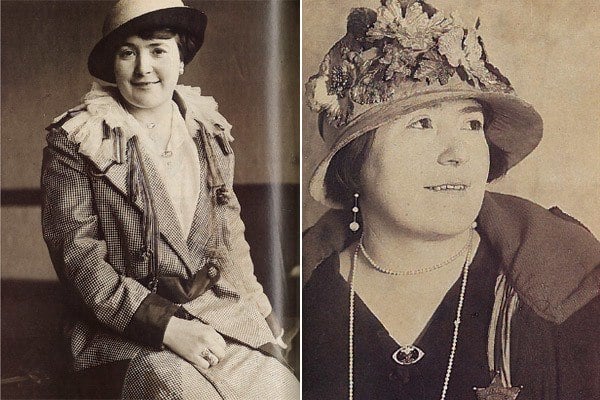
Turn of the century reporters summed Alice Clement up as “furs, heels and jujitsu.” Appointed on August 5th, 1913, Clement was the only woman in the class of almost 100 new police detectives and would remain so for many years after.
Clement’s appearance was often the focus of the day’s newspapers, and it may not have been entirely because she was female. The 5’3” detective would routinely bust onto a Chicago crime scene in beautiful gowns and an attractive bobbed haircut en vogue in the early 1920s–all while brandishing a tommy gun. If Clement’s choice of livery didn’t announce her presence, her larger-than life personality certainly did.
Clement’s trademark command, which has become something of a crime-drama standard these days, often announced her presence before her glittering jewels: “Back! Line up! Right against that wall!”

Source: Chicago Magazine
While some newspapers of the day poked fun at her, Alice Clement made no apologies whatsoever for her femininity. In fact, she owned it.
She was also seriously passionate about her work and didn’t see any reason that the two aspects of her personality need be mutually exclusive: each night she lay her roller-clad head down for some beauty sleep — with her gun under her pillow. Her girl-power belief system extended into social issues of the day, and she was a major advocate not just for women’s rights (including, of course The Vote) but the repeal of prohibition.
She also believed in a woman’s right to become independent from a stale marriage and herself sued her first husband for divorce (in an era where it was virtually unheard of to do so) for “desertion and intemperance.” It took four years for the divorce to be granted, but as soon as it was, she married her second husband — in the presence of a female pastor.
Clement certainly had plenty of fans in the media, but not necessarily among the police force. Her superior, a man named Chief McWeeny, eventually became so fed up with her successful presence there, and the eventual addition of new female PDs, that he resigned. However, many of those on the force and around Chicago crime scenes recognized the value of female PDs who could go undercover and infiltrate otherwise difficult to bust crime scenes.
One of her most famous cases inspired an Agatha Christie serial, The Dulcimer, which involved the murder of a young woman who was most likely a prostitute gravely ill with Typhoid. The male detectives on the force assumed that she’d simply succumbed to her “lifestyle” but Clement remained unconvinced. Further investigation revealed that the woman had, in fact, acquired Typhoid as part of a murder plot, the germs entering her body via the strings of a dulcimer she played.
The young woman had recently come into a sizeable inheritance, and an aunt of hers wanted to claim it as her own. Looking for a way to kill the young woman and claim the property as hers, the aunt infected the dulcimer strings with Typhoid bacteria, which succeeded in killing the young woman. Clement’s hunch, and subsequent investigation, revealed that in between the plucking of strings, the young woman would often lick her fingers — giving the aunt’s plan to infect the instrument full credence.

When Alice Clement went to apprehend the aunt for the murder, she got a confession — but never got her to fully admit the motive. Before they were able to remove her from the home, the woman stabbed herself in the neck with a pen knife, a mortal wound from which she did not recover.
Clement wasn’t all about the high-profile murders, though. She was just as likely to be seen aiding in the rescue of civilians after a street accident, or, as one reporter tells it, wading into the harbor (in her pearls and frock, no less) to rescue passengers from a capsized vessel.
Clement also walked the city streets, rescuing runaways and destitute girls, giving them hope when she could. Years of these types of interactions inspired Clement to create a film, Dregs of the City, which ran in theatres alongside Ethel Barrymore films and had quite a favorable response—in every city except Chicago, which forbade her to show it there. The city archives, unfortunately, have not been able to locate the film; all we have are a few promotional stills.

Dregs of the City Source: Chicago Magazine
In the wake of the film, Clement collaborated with the media to profile several girls who ruled Chicago’s streets: teenage runaways, prostitutes and showgirls graced the front page of the paper, sharing their stories and giving some humanity to the much wider social issues for women of the day.
This fame didn’t do much for Clement’s relationship with the male-dominated police force, and by the mid 1920s, the tension really began to take its toll. She was demoted and shortly thereafter forced into a medical leave in 1926 due to complications from diabetes, which she had hidden adeptly throughout her entire career. Clement deteriorated quickly, dying the day after Christmas in 1926 at the age of 49.
Her funeral was practically a state event, and Clement was honored not just by her male colleagues, but the growing population of female police detectives whose numbers Clement had no doubt helped create. Her gravestone, however, is a simple unmarked stone that does not bear the well-deserved police star that she would have been most deserving of.
Today there are over 900,000 police officers serving in the United States. 12 percent of them are female. In Alice Clement’s heyday, she was practically one in a million. While she seems to be all but forgotten to history, as very little has been written about her, her influence is clear.
Clement’s career helped incite cultural and institutional changes regarding women and security, and if we can’t see it by the number of successful female cops in America’s cities today, we certainly can via the collection of tough gal cops made famous by television crime drama.





